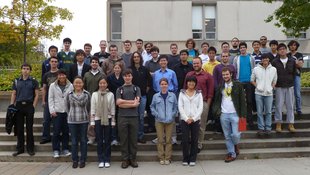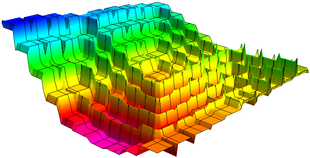The printable version is no longer supported and may have rendering errors. Please update your browser bookmarks and please use the default browser print function instead.
| Additions to the MAT 327 web site no longer count towards good deed points
|
| #
|
Week of...
|
Notes and Links
|
| 1
|
Sep 13
|
About This Class, Monday - Continuity and open sets, Thursday - topologies, continuity, bases.
|
| 2
|
Sep 20
|
Monday - More on bases, Thursdsay - Products, Subspaces, Closed sets, HW1, HW1 Solutions
|
| 3
|
Sep 27
|
Monday - the Cantor set, closures, Thursday, Class Photo, HW2, HW2 Solutions
|
| 4
|
Oct 4
|
Monday - the axiom of choice and infinite product spaces, Thursday - the box and the product topologies, metric spaces, HW3, HW3 Solutions
|
| 5
|
Oct 11
|
Monday is Thanksgiving. Thursday - metric spaces, sequencial closures, various products. Final exam's date announced on Friday.
|
| 6
|
Oct 18
|
Monday - connectedness in  , HW4, HW4 Solutions, Thursday - connectedness, path-connectedness and products , HW4, HW4 Solutions, Thursday - connectedness, path-connectedness and products
|
| 7
|
Oct 25
|
Monday - Compactness of ![{\displaystyle [0,1]}](https://wikimedia.org/api/rest_v1/media/math/render/svg/738f7d23bb2d9642bab520020873cccbef49768d) , Term Test on Thursday, TT Solutions , Term Test on Thursday, TT Solutions
|
| 8
|
Nov 1
|
Monday - compact is closed and bounded, maximal values, HW5, HW5 Solutions, Wednesday was the last date to drop this course, Thursday - compactness of products and in metric spaces, the FIP
|
| 9
|
Nov 8
|
Monday-Tuesday is Fall Break, Thursday - Tychonoff and a taste of Stone-Cech, HW6, HW6 Solutions
|
| 10
|
Nov 15
|
Monday - generalized limits, Thursday - Normal spaces and Urysohn's lemma, HW7, HW7 Solutions
|
| 11
|
Nov 22
|
Monday -  and and  , Thursday - Tietze's theorem , Thursday - Tietze's theorem
|
| 12
|
Nov 29
|
Monday - compactness in metric spaces, HW8, HW8 Solutions, Thursday - completeness and compactness
|
| 13
|
Dec 6
|
Monday - Baire spaces and no-where differentiable functions, Wednesday - Hilbert's 13th problem; also see December 2010 Schedule
|
| R
|
Dec 13
|
See December 2010 Schedule
|
| F
|
Dec 20
|
Final exam, Monday December 20, 2PM-5PM, at BR200
|
| Register of Good Deeds
|

Add your name / see who's in!
|

See Hilbert's 13th
|
|
Reading
Read sections  in Munkres' textbook (Topology, 2nd edition). Remember that reading math isn't like reading a novel! If you read a novel and miss a few details most likely you'll still understand the novel. But if you miss a few details in a math text, often you'll miss everything that follows. So reading math takes reading and rereading and rerereading and a lot of thought about what you've read. Also, preread sections
in Munkres' textbook (Topology, 2nd edition). Remember that reading math isn't like reading a novel! If you read a novel and miss a few details most likely you'll still understand the novel. But if you miss a few details in a math text, often you'll miss everything that follows. So reading math takes reading and rereading and rerereading and a lot of thought about what you've read. Also, preread sections  , just to get a feel for the future.
, just to get a feel for the future.
Doing
Solve and submit the following problems from Munkres' book:
- Problem 1 on page 199.
- Problem 1 on page 205.
- Problems 1, 4, 5, 8, 9 on pages 212-213.
Remark. The following fact, which we will prove later, may be used without a proof: If  is a topological space and
is a topological space and ![{\displaystyle f_{n}:X\to [0,1]}](https://wikimedia.org/api/rest_v1/media/math/render/svg/d63aafa3453fd31fb01ad87165a4da938d583c98) are continuous functions, then the sum
are continuous functions, then the sum  is convergent and defines a continuous function on
is convergent and defines a continuous function on  .
.
Due date
This assignment is due at the end of class on Thursday, November 25, 2010.
|
|
Dror's notes above / Student's notes below
|
|
- Question: In problem 1 p205, is asks us to show that any closed subspace of a normal space is also normal. Do we really need the condition that the subspace be closed? - Jdw
- Yes. Drorbn 19:14, 19 November 2010 (EST)
Questions by Kai Xwbdsb 21:26, 19 November 2010 (EST) were moved to Classnotes for Thursday November 18 as they are about that class and not about this assignment. Drorbn 06:03, 20 November 2010 (EST)
- Question. If we have a finite set of continuous function mapping from any topological space into the reals. Any linear combination of these continuous function is still continuous right? The proof is a little extension of 157 proof. This is used to prove the statement you mentioned above. -KaiXwbdsb 17:14, 20 November 2010 (EST)
- Any linear combination of functions from
 (an uncountable set unless X is empty) is continuous. On its own, however, this proves nothing about infinite sums. Bcd 22:32, 21 November 2010 (EST)
(an uncountable set unless X is empty) is continuous. On its own, however, this proves nothing about infinite sums. Bcd 22:32, 21 November 2010 (EST)
- Question about 9. Is J any indexing set? Possibly uncountable? in the hint: A means any closed set? -Kai Xwbdsb 22:13, 20 November 2010 (EST)
- Yes,
 is arbitrary and
is arbitrary and  is closed. Drorbn 06:41, 22 November 2010 (EST)
is closed. Drorbn 06:41, 22 November 2010 (EST)

![{\displaystyle [0,1]}](https://wikimedia.org/api/rest_v1/media/math/render/svg/738f7d23bb2d9642bab520020873cccbef49768d)







![{\displaystyle f_{n}:X\to [0,1]}](https://wikimedia.org/api/rest_v1/media/math/render/svg/d63aafa3453fd31fb01ad87165a4da938d583c98)



